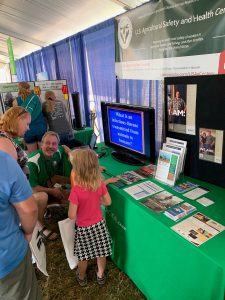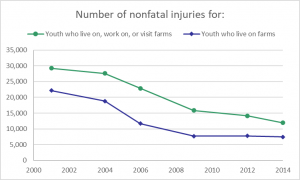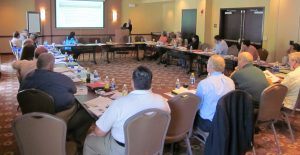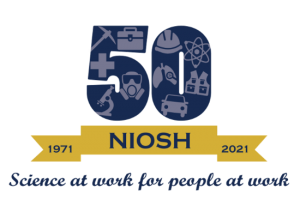30 Years of the NIOSH Agriculture, Forestry and Fishing Program
Posted on by
As NIOSH celebrates half a century of work in occupational safety and health, the Institute’s Agriculture, Forestry, and Fishing (AgFF) Program reflects on 30 years of research and outreach designed to protect the people who produce our nation’s food and fiber. The AgFF Program began in response to a rise of farmer safety concerns from the Midwest and Northeast.1 To address long-standing high rates of fatalities, injuries, and illness in agriculture, Congress established a national initiative in agricultural safety and health under Public Law (P.L.) 101-517. As a result of this, NIOSH developed a program at the direction of Congress in 1990 to address risks in agriculture with a focus on surveillance, special populations, health effects, control systems, and outreach mechanisms.

Thirty years ago, $20 million annually was allocated for the NIOSH AgFF Program, and today the program receives $26.5 million. The burden of U.S. agricultural injuries and illnesses are assessed at $7.6 billion annually in medical and lost productivity costs. 2 Compared to the average U.S. worker, AgFF workers are more likely to die on the job by: 6x in agriculture, 29x in forestry, and 23x in commercial fishing.3
Because of the trailblazers who initiated this movement and many others committed to advancing the welfare of essential industries and communities within the AgFF sector, the AgFF program has grown and evolved as shown in the timeline of events featured below.
AgFF Program Evolution
1991 Regional Ag Centers

An innovative feature of P.L. 101‐517 was the establishment of university-based, regional Centers for Agricultural Disease and Injury Research, Education, and Prevention (Ag Centers).4 In 1991, three Centers were awarded cooperative agreements with NIOSH. They were based in New York, Wisconsin, and California. In FY 2015, the Ag Centers’ name changed from the Centers for Agricultural Disease and Injury Research, Education, and Prevention to the Centers for Agricultural Safety and Health. Currently there are 10 regional Centers and one national Center with a focus on farm children. The Centers respond to regional needs, coordinate on national prevention programs, and work in collaboration with NIOSH intramural programs. Through partnerships with growers, farmworkers, and service providers, the Ag Centers developed a portfolio of research and evidence‐based solutions that have informed changes in policy and practice. The Ag Centers’ respectful engagement has built a new era of community-engaged academic research, including projects with vulnerable worker communities, such as children and immigrant workers. Since the Centers’ inception, there have been significant advances in the areas of pesticide exposure, pulmonary disease, musculoskeletal disorders, traumatic injury, heat illness, and stress.
1991 Commercial Fishing

NIOSH established the Alaska Field Station (AFS) in 1991, at the invitation of the Alaska Department of Health and Social Services and Alaska Area Native Health Service. Previously, Alaska had the highest work-related fatality rate of any state. Commercial fishing became a focus in the first 15 years of the AFS, conducting strategic prevention programs that were then extended across the U.S. with interagency and Ag Center partners. U.S. commercial fishing had a fatality rate 58 times higher than the rate for all U.S. workers in 2009. NIOSH research has shown that knowledge of maritime navigation rules, vessel stability, and emergency preparedness are essential. These and other solutions are shared at Commercial Fishing Safety: Impacts. U.S. commercial fishing fatalities have decreased by 39% from 2000-2015. Today, commercial fishing safety research is coordinated through the NIOSH Center for Maritime Safety and Health Studies. Fishing safety specialists convene through the IFISH Conference and new projects are supported through the Commercial Fishing Occupational Safety Research and Training Program grants in partnership with the US Coast Guard.
1992 Injury and Illness Surveillance
NIOSH began a strategic surveillance program for agriculture in 1992 with the Sentinel Event Notification System for Occupational Risk (SENSOR) Pesticide Program, and in 1996 launched injury surveillance of farm youth and workers. For 25 years, the Institute partnered with the U.S. Department of Labor (DOL) and U.S. Department of Agriculture (USDA) to conduct targeted national surveys. In 2015, NIOSH began a rigorous examination to reshape its approach to agricultural injury surveillance. New directions for smarter national agricultural injury and illness surveillance include: expanding use of biomedical informatics; inclusion of occupation and industry in health records systems; and, collaborative projects with state programs and regional Ag Centers. 5
1997 Farm Children & Youth

Raising children on farms is an invaluable experience. However, farming is one of the most hazardous industries in the U.S. with about 33 children seriously injured on farms and ranches each day. This was the basis for a new Center, the National Children’s Center for Rural and Agricultural Health and Safety (NCCRAHS). This focused Center was charged with protecting the nation’s children and youth who live or work on farms from the hazards found in specific jobs, locations, and practices. Between 1998 and 2009, the rate of non‐fatal agricultural injuries among children per 1,000 farms dropped by 59 percent. The impact of the Center in reducing injuries on farms was recognized in MMWR as one of the greatest Public Health Achievements of the Decade. Work is continuing and supported by a broad base of public and private partnerships through the Children’s’ Agricultural Safety Network.
2005 Tractor Safety

On July 28, 2005 the NIOSH Ag Centers launched the Tractor Safety Initiative. This cross-center collaboration aimed to prevent the top traumatic fatality on U.S. farms, tractor overturns. Ag Center research has shown that the use of rollover protective structures (ROPS or rollbars) and seatbelts on tractors can prevent 98 percent of overturn related deaths. In 2008, NIOSH designed and tested Cost-effective Rollover Protective Structures (CROPS). A program from the Northeast Center for Occupational Health and Safety (NEC) in New York developed state partnerships to offer farmer rebates on ROPS, increasing the installation of ROPS by 10-fold and generating more than $3.75 for every dollar invested. A multi-sector workgroup, National Tractor Safety Coalition, was formed in 2014 and currently has over 80 members throughout the United States. In 2017, the Coalition worked in partnership with the NEC to launch a National ROPS Rebate Program.
2006 National Occupational Research Agenda

The National Occupational Research Agenda (NORA) is a partnership program stewarded by NIOSH to stimulate innovative research and improved workplace practices. The first National Occupational Research Agenda for Agriculture, Forestry and Fishing began in 2006, starting with a Town Hall bringing together the AgFF community for in-person testimonies from across the nation. The research agenda provides a vehicle for partners to describe the most relevant safety and health issues, research gaps, and needs for the AgFF sector. Now in its third decade (2016-2026), individuals and organizations are invited to join NORA Councils to share information, form partnerships, and promote adoption and dissemination of solutions that work.
2011 Office of Agriculture Safety and Health
NIOSH established the Office of Agriculture Safety and Health (OASH) within the Office of the Director. OASH is responsible for the NIOSH AgFF program and sets strategic directions and supports the promotion of evidence-based recommendations to reduce risks of work-related injuries and illnesses. OASH also bridges internal and external activities by facilitating research integration, partnership development, and research to practice.
2015 Forestry
NIOSH issued a national call to address vulnerable workers in AgFF, with an explicit emphasis on forestry work, with a Request for Applications for research funding.6 Forest work ranks among the most dangerous in the U.S, with fatal work injury rates for loggers recorded at more than 30 times the all-worker fatal injury rate. In response, four new projects were awarded, addressing new hazards with steep-slope mechanized logging, new Latino immigrant workforces, safety solutions using GPS systems, and supervisor training tools. This call set a new priority for Ag Centers and schools of forestry to integrate safety into logging and forestry services activities. Forestry and logging research and outreach continues to evolve as the industry faces high demand and work pressures to reduce wildfire risks and provide sustainable timber products.
Currently, AgFF safety and health professionals work to address emerging risks such as new worker populations, changing employment structures, and rapidly developing technologies. The AgFF Program is responding to these issues by working with industry and community partners, developing innovative exposure assessment methods, and testing the feasibility of new solutions. At times, the Ag Centers and NIOSH AgFF leaders joined forces to address emergencies such as disease outbreaks (avian flu) and disasters (flooding, wildfires). There is no better example of collaboration than the COVID-19 pandemic and the rapid response of our teams and partners which resulted in them co-developing countless resources, studies, and communications with the AgFF Program. The development of the COVID-19 guidance for agricultural workers and employers was led by the AgFF Program in a national collaboration across federal agencies, NIOSH Agricultural Centers, and partners.
The AgFF Program is only successful with the help of active learners and partnerships, so please join us in our mission. We invite you to our meetings and forums. Please join our NORA AgFF Sector Council to discuss a variety of occupational safety and health topics. While we publish widely, many notable articles can be found in the Journal of Agromedicine. Find your regional Ag Center at Centers for Agricultural Safety and Health and search for educational videos on Agricultural Centers’ YouTube channel.
This program’s success is a reflection of a relatively small, but dedicated, group. We also recognize the founding generation of inspired public health researchers and practitioners who began this work to save lives. Thank you for the work you do; and thank you to those who produce food and fiber within the agriculture, forestry, and fishing industries.
This is not the end of our story or this blog! Please read and use the comments section to share your NIOSH AgFF safety and health success stories…
Marcy Harrington is the Program Manager of the Pacific Northwest Agricultural Safety and Health Center.
Amanda Wickman is the Program Director for the Southwest Center for Agricultural Health, Injury Prevention and Education
Donjanea F. Williams is a Health Communication Specialist in the NIOSH Office of Extramural Programs.
Jennifer M. Lincoln is the Associate Director of the NIOSH Office of Agriculture Safety and Health.
 This blog is part of a series for the NIOSH 50th Anniversary. Stay up to date on how we’re celebrating NIOSH’s 50th Anniversary on our website.
This blog is part of a series for the NIOSH 50th Anniversary. Stay up to date on how we’re celebrating NIOSH’s 50th Anniversary on our website.
References
1 The National Coalition for Agricultural Safety and Health (1989). Agriculture at Risk: A Report to the Nation.
2 This is an inflation adjusted estimate of the 1992 estimates of $4.57 billion that appeared in Leigh, J., McCurdy, S., & Schenker, M. (2001). Costs of Occupational Injuries in Agriculture. Public Health Report, 116(3), 235-248
3 U.S. Bureau of Labor Statistics, Census of Fatal Occupational Injuries (CFOI) – Civilian Occupational Death Rates. Average over 2019, 2018, 2017.
4 National Research Council (2007). Agriculture, Forestry, and Fishing Research at NIOSH
5 NIOSH-CDC. Status of National Agriculture Injury Surveys | NIOSH | CDC.
6 NIOSH-CDC PAR-14-175 Agricultural, Forestry and Fishing Safety and Health Research (U01).
Posted on by

